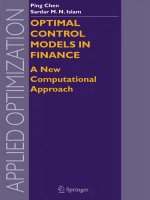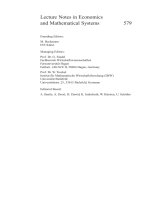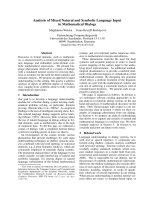Advances in Mathematical Finance pdf
Bạn đang xem bản rút gọn của tài liệu. Xem và tải ngay bản đầy đủ của tài liệu tại đây (5.36 MB, 345 trang )
Applied and Numerical Harmonic Analysis
Series Editor
John J. Benedetto
University of Maryland
Editorial Advisory Board
Akram Aldroubi Douglas Cochran
Vanderbilt University Arizona State University
Ingrid Daubechies Hans G. Feichtinger
Princeton University University of Vienna
Christopher Heil Murat Kunt
Georgia Institute of Technology Swiss Federal Institute of Technology, Lausanne
James McClellan Wim Sweldens
Georgia Institute of Technology Lucent Technologies, Bell Laboratories
Michael Unser Martin Vetterli
Swiss Federal Institute Swiss Federal Institute
of Technology, Lausanne of Technology, Lausanne
M. Victor Wickerhauser
Washington University
Advances in
Mathematical Finance
Michael C. Fu
Robert A. Jarrow
Ju-Yi J. Yen
Robert J. Elliott
Editors
Birkh
¨
auser
Boston
•
Basel
•
Berlin
Michael C. Fu
Robert H. Smith School of Business
Van Munching Hall
University of Maryland
College Park, MD 20742
USA
Robert A. Jarrow
Johnson Graduate School of Management
451 Sage Hall
Cornell University
Ithaca, NY 14853
USA
Ju-Yi J. Yen
Department of Mathematics
1326 Stevenson Center
Vanderbilt University
Nashville, TN 37240
USA
Robert J. Elliott
Haskayne School of Business
Scurfield Hall
University of Calgary
Calgary, AB T2N 1N4
Canada
Cover design by Joseph Sherman.
Mathematics Subject Classification (2000): 91B28
Library of Congress Control Number: 2007924837
ISBN-13: 978-0-8176-4544-1 e-ISBN-13: 978-0-8176-4545-8
Printed on acid-free paper.
c
2007 Birkh
¨
auser Boston
All rights reserved. This work may not be translated or copied in whole or in part without the written
permission of the publisher (Birkh
¨
auser Boston, c/o Springer Science+Business Media LLC, 233
Spring Street, New York, NY 10013, USA) and the author, except for brief excerpts in connection with
reviews or scholarly analysis. Use in connection with any form of information storage and retrieval,
electronic adaptation, computer software, or by similar or dissimilar methodology now known or
hereafter developed is forbidden.
The use in this publication of trade names, trademarks, service marks and similar terms, even if they
are not identified as such, is not to be taken as an expression of opinion as to whether or not they are
subject to proprietary rights.
987654321
www.birkhauser.com (KeS/EB)
In honor of Dilip B. Madan on the occasion of his 60th birthday
ANHA Series Preface
The Applied and Numerical Harmonic Analysis (ANHA) book series aims to
provide the engineering, mathematical, and scientific communities with sig-
nificant developments in harmonic analysis, ranging from abstract harmonic
analysis to basic applications. The title of the series reflects the importance
of applications and numerical implementation, but richness and relevance of
applications and implementation depend fundamentally on the structure and
depth of theoretical underpinnings. Thus, from our point of view, the inter-
leaving of theory and applications and their creative symbiotic evolution is
axiomatic.
Harmonic analysis is a wellspring of ideas and applicability that has flour-
ished, developed, and deepened over time within many disciplines and by
means of creative cross-fertilization with diverse areas. The intricate and fun-
damental relationship between harmonic analysis and fields such as signal
processing, partial differential equations (PDEs), and image processing is re-
flected in our state-of-the-art ANHA series.
Our vision of modern harmonic analysis includes mathematical areas such
as wavelet theory, Banach algebras, classical Fourier analysis, time-frequency
analysis, and fractal geometry, as well as the diverse topics that impinge on
them.
For example, wavelet theory can be considered an appropriate tool to
deal with some basic problems in digital signal processing, speech and image
processing, geophysics, pattern recognition, biomedical engineering, and tur-
bulence. These areas implement the latest technology from sampling methods
on surfaces to fast algorithms and computer vision methods. The underlying
mathematics of wavelet theory depends not only on classical Fourier analysis,
but also on ideas from abstract harmonic analysis, including von Neumann
algebras and the affine group. This leads to a study of the Heisenberg group
and its relationship to Gabor systems, and of the metaplectic group for a
meaningful interaction of signal decomposition methods. The unifying influ-
ence of wavelet theory in the aforementioned topics illustrates the justification
viii ANHA Series Preface
for providing a means for centralizing and disseminating information from the
broader, but still focused, area of harmonic analysis. This will be a key role
of ANHA. We intend to publish with the scope and interaction that such a
host of issues demands.
Along with our commitment to publish mathematically significant works at
the frontiers of harmonic analysis, we have a comparably strong commitment
to publish major advances in the following applicable topics in which harmonic
analysis plays a substantial role:
Antenna theory P rediction theory
Biomedical signal processing Radar applications
Digital signal processing Sampling theory
F ast algorithms Spectral estimation
Gabor theory and applications Speech processing
Image processing Time-frequency and
Numerical partial differential equations time-scale analysis
Wavelet theory
The above point of view for the ANHA book series is inspired by the
history of Fourier analysis itself, whose tentacles reach into so many fields.
In the last two centuries Fourier analysis has had a major impact on the
development of mathematics, on the understanding of many engineering and
scientific phenomena, and on the solution of some of the most important prob-
lems in mathematics and the sciences. Historically, Fourier series were devel-
oped in the analysis of some of the classical PDEs of mathematical physics;
these series were used to solve such equations. In order to understand Fourier
series and the kinds of solutions they could represent, some of the most basic
notions of analysis were defined, e.g., the concept of “function.” Since the
coefficients of Fourier series are integrals, it is no surprise that Riemann inte-
grals were conceived to deal with uniqueness properties of trigonometric series.
Cantor’s set theory was also developed because of such uniqueness questions.
A basic problem in Fourier analysis is to show how complicated phenom-
ena, such as sound waves, can be described in terms of elementary harmonics.
There are two aspects of this problem: first, to find, or even define properly,
the harmonics or spectrum of a given phenomenon, e.g., the spectroscopy
problem in optics; second, to determine which phenomena can be constructed
from given classes of harmonics, as done, for example, by the mechanical syn-
thesizers in tidal analysis.
Fourier analysis is also the natural setting for many other problems in
engineering, mathematics, and the sciences. For example, Wiener’s Tauberian
theorem in Fourier analysis not only characterizes the behavior of the prime
numbers, but also provides the proper notion of spectrum for phenomena such
as white light; this latter process leads to the Fourier analysis associated with
correlation functions in filtering and prediction problems, and these problems,
in turn, deal naturally with Hardy spaces in the theory of complex variables.
ANHA Series Preface ix
Nowadays, some of the theory of PDEs has given way to the study of
Fourier integral operators. Problems in antenna theory are studied in terms
of unimodular trigonometric polynomials. Applications of Fourier analysis
abound in signal processing, whether with the fast Fourier transform (FFT),
or filter design, or the adaptive modeling inherent in time-frequency-scale
methods such as wavelet theory. The coherent states of mathematical physics
are translated and modulated Fourier transforms, and these are used, in con-
junction with the uncertainty principle, for dealing with signal reconstruction
in communications theory. We are back to the raison d’ˆetre of the ANHA
series!
John J. Benedetto
Series Editor
University of Maryland
College Park
Preface
The “Mathematical Finance Conference in Honor of the 60th Birthday of
Dilip B. Madan” was held at the Norbert Wiener Center of the University
of Maryland, College Park, from September 29 – October 1, 2006, and this
volume is a Festschrift in honor of Dilip that includes articles from most of the
conference’s speakers. Among his former students contributing to this volume
are Ju-Yi Yen as one of the co-editors, along with Ali Hirsa and Xing Jin as
co-authors of three of the articles.
Dilip Balkrishna Madan was born on December 12, 1946, in Washington,
DC, but was raised in Bombay, India, and received his bachelor’s degree in
Commerce at the University of Bombay. He received two Ph.D.s at the Uni-
versity of Maryland, one in economics and the other in pure mathematics.
What is all the more amazing is that prior to entering graduate school he had
never had a formal university-level mathematics course! The first section of
the book summarizes Dilip’s career highlights, including distinguished awards
and editorial appointments, followed by his list of publications.
The technical contributions in the book are divided into three parts. The
first part deals with stochastic processes used in mathematical finance, pri-
marily the L´evy processes most associated with Dilip, who has been a fervent
advocate of this class of processes for addressing the well-known flaws of geo-
metric Brownian motion for asset price modeling. The primary focus is on the
Variance-Gamma (VG) process that Dilip and Eugene Seneta introduced to
the finance community, and the lead article provides an historical review from
the unique vantage point of Dilip’s co-author, starting from the initiation of
the collaboration at the University of Sydney. Techniques for simulating the
Variance-Gamma process are surveyed in the article by Michael Fu, Dilip’s
longtime colleague at Maryland, moving from a review of basic Monte Carlo
simulation for the VG process to more advanced topics in variation reduction
and efficient estimation of the “Greeks” such as the option delta. The next
two pieces by Marc Yor, a longtime close collaborator and the keynote speaker
at the birthday conference, provide some mathematical properties and iden-
tities for gamma processes and beta and gamma random variables. The final
article in the first part of the volume, written by frequent collaborator Robert
Elliott and his co-author John van der Hoek, reviews the theory of fractional
Brownian motion in the white noise framework and provides a new approach
for deriving the associated Itˆo-type stochastic calculus formulas.
xii Preface
The second part of the volume treats various aspects of mathematical fi-
nance related to asset pricing and the valuation and hedging of derivatives.
The article by Bob Jarrow, a longtime collaborator and colleague of Dilip in
the mathematical finance community, provides a tutorial on zero volatility
spreads and option adjusted spreads for fixed income securities – specifically
bonds with embedded options – using the framework of the Heath-Jarrow-
Morton model for the term structure of interest rates, and highlights the
characteristics of zero volatility spreads capturing both embedded options and
mispricings due to model or market errors, whereas option adjusted spreads
measure only the mispricings. The phenomenon of market bubbles is addressed
in the piece by Bob Jarrow, Phillip Protter, and Kazuhiro Shimbo, who pro-
vide new results on characterizing asset price bubbles in terms of their martin-
gale properties under the standard no-arbitrage complete market framework.
General equilibrium asset pricing models in incomplete markets that result
from taxation and transaction costs are treated in the article by Xing Jin –
who received his Ph.D. from Maryland’s Business School co-supervised by
Dilip – and Frank Milne – one of Dilip’s early collaborators on the VG model.
Recent work on applying L´evy processes to interest rate modeling, with a
focus on real-world calibration issues, is reviewed in the article by Wolfgang
Kluge and Ernst Eberlein, who nominated Dilip for the prestigious Humboldt
Research Award in Mathematics. The next two articles, both co-authored by
Ali Hirsa, who received his Ph.D. from the math department at Maryland co-
supervised by Dilip, focus on derivatives pricing; the sole article in the volume
on which Dilip is a co-author, with Massoud Heidari as the other co-author,
prices swaptions using the fast Fourier transform under an affine term struc-
ture of interest rates incorporating stochastic volatility, whereas the article
co-authored by Peter Carr – another of Dilip’s most frequent collaborators –
derives forward partial integro-differential equations for pricing knock-out call
options when the underlying asset price follows a jump-diffusion model. The
final article in the second part of the volume is by H´elyette Geman, Dilip’s
longtime collaborator from France who was responsible for introducing him
to Marc Yor, and she treats energy commodity price modeling using real his-
torical data, testing the hypothesis of mean reversion for oil and natural gas
prices.
The third part of the volume includes several contributions in one of the
most rapidly growing fields in mathematical finance and financial engineering:
credit risk. A new class of reduced-form credit risk models that associates
default events directly with market information processes driving cash flows is
introduced in the piece by Dorje Brody, Lane Hughston, and Andrea Macrina.
A generic one-factor L´evy model for pricing collateralized debt obligations
that unifies a number of recently proposed one-factor models is presented in
the article by Hansj¨org Albrecher, Sophie Ladoucette, and Wim Schoutens.
An intensity-based default model that prices credit derivatives using utility
functions rather than arbitrage-free measures is proposed in the article by
Ronnie Sircar and Thaleia Zariphopoulou. Also using the utility-based pricing
Preface xiii
approach is the final article in the volume by Marek Musiela and Thaleia
Zariphopoulou, and they address the integrated portfolio management optimal
investment problem in incomplete markets stemming from stochastic factors
in the underlying risky securities.
Besides being a distinguished researcher, Dilip is a dear friend, an esteemed
colleague, and a caring mentor and teacher. During his professional career,
Dilip was one of the early pioneers in mathematical finance, so it is only
fitting that the title of this Festschrift documents his past and continuing love
for the field that he helped develop.
Michael Fu
Bob Jarrow
Ju-Yi Yen
Robert Elliott
December 2006
xiv Preface
Conference poster (designed by Jonathan Sears).
Preface xv
Photo Highlights (September 29, 2006)
Dilip delivering his lecture.
Dilip with many of his Ph.D. students.
xvi Preface
Norbert Wiener Center director John Benedetto and Robert Elliott.
Left to right: CGMY (Carr, Geman, Madan, Yor).
Preface xvii
VG inventors (Dilip and Eugene Seneta) with the Madan family.
Dilip’s wife Vimla cutting the birthday cake.
Career Highlights and List of Publications
Dilip B. Madan
Robert H. Smith School of Business
Department of Finance
University of Maryland
College Park, MD 20742, USA
Career Highlights
1971 Ph.D. Economics, University of Maryland
1975 Ph.D. Mathematics, University of Maryland
2006 recipient of Humboldt Research Award in Mathematics
President of Bachelier Finance Society 2002–2003
Managing Editor of Mathematic Finance, Review of Derivatives Research
Series Editor on Financial Mathematics for CRC, Chapman and Hall
Associate Editor for Quantitative Finance, Journal of Credit Risk
1971–1975: Assistant Professor of Economics, University of Maryland
1976–1979: Lecturer in Economic Statistics, University of Sydney
1980–1988: Senior Lecturer in Econometrics, University of Sydney
1981–1982: Acting Head, Department of Econometrics, Sydney
1989–1992: Assistant Professor of Finance, University of Maryland
1992–1997: Associate Professor of Finance, University of Maryland
1997–present: Professor of Finance, University of Maryland
Visiting Positions:
La Trobe University, Cambridge University (Isaac Newton Institute),
Cornell University, University Paris,VI, University of Paris IX at Dauphine
Consulting:
Morgan Stanley, Bloomberg, Wachovia Securities, Caspian Capital, FDIC
xx Dilip B. Madan
Publications (as of December 2006 (60th birthday))
1. The relevance of a probabilistic form of invertibility. Biometrika, 67(3):704–
5, 1980 (with G. Babich).
2. Monotone and 1-1 sets. Journal of the Australian Mathematical Society,
Series A, 33:62–75, 1982 (with R.W. Robinson).
3. Resurrecting the discounted cash equivalent flow. Abacus, 18-1:83–90,
1982.
4. Differentiating a determinant. The American Statistician, 36(3):178–179,
1982.
5. Measures of risk aversion with many commodities. Economics Letters,
11:93–100, 1983.
6. Inconsistent theories as scientific objectives. Journal of the Philosophy of
Science, 50(3):453–470, 1983.
7. Testing for random pairing. Journal of the American Statistical Associa-
tion, 78(382):332–336, 1983 (with Piet de Jong and Malcolm Greig).
8. Compound Poisson models for economic variable movements. Sankhya
Series B, 46(2):174–187, 1984 (with E. Seneta).
9. The measurement of capital utilization rates. Communications in Statis-
tics: Theory and Methods, A14(6):1301–1314, 1985.
10. Project evaluations and accounting income forecasts. Abacus, 21(2):197–
202, 1985.
11. Utility correlations in probabilistic choice modeling. Economics Letters,
20:241–245, 1986.
12. Mode choice for urban travelers in Sydney. Proceedings of the 13th ARRB
and 5th REAAA Conference, 13(8):52–62, 1986 (with R. Groenhout and
M. Ranjbar).
13. Simulation of estimates using the empirical characteristic function. Inter-
national Statistical Review, 55(2):153–161, 1987 (with E. Seneta).
14. Chebyshev polynomial approximations for characteristic function estima-
tion. Journal of the Royal Statistical Society, Series B, 49(2):163–169,
1987 (with E. Seneta).
15. Modeling Sydney work trip travel mode choices. Journal of Transportation
Economics and Policy, XXI(2):135–150, 1987 (with R. Groenhout).
16. Optimal duration and speed in the long run. Review of Economic Studies,
54a(4a):695–700, 1987.
17. Decision theory with complex uncertainties. Synthese, 75:25–44, 1988
(with J.C. Owings).
18. Risk measurement in semimartingale models with multiple consumption
goods. Journal of Economic Theory, 44(2):398–412, 1988.
19. Stochastic stability in a rational expectations model of a small open econ-
omy. Economica, 56(221):97–108, 1989 (with E. Kiernan).
20. Dynamic factor demands with some immediately productive quasi fixed
factors. Journal of Econometrics, 42:275–283, 1989 (with I. Prucha).
Career Highlights and List of Publications xxi
21. Characteristic function estimation using maximum likelihood on trans-
formed variables. Journal of the Royal Statistical Society, Series B,
51(2):281–285, 1989 (with E. Seneta).
22. The multinomial option pricing model and its Brownian and Poisson lim-
its. Review of Financial Studies, 2(2):251–265, 1989 (with F. Milne and
H. Shefrin).
23. On the monotonicity of the labour-capital ratio in Sraffa’s model. Journal
of Economics, 51(1):101–107, 1989 (with E. Seneta).
24. The Variance-Gamma (V.G.) model for share market returns. Journal of
Business, 63(4):511–52,1990 (with E. Seneta).
25. Design and marketing of financial products. Review of Financial Studies,
4(2):361–384, 1991 (with B. Soubra).
26. A characterization of complete security markets on a Brownian filtration.
Mathematical Finance, 1(3):31–43, 1991 (with R.A. Jarrow).
27. Option pricing with VG Martingale components. Mathematical Finance,
1(4):39–56, 1991 (with F. Milne).
28. Informational content in interest rate term structures. Review of Eco-
nomics and Statistics, 75(4):695–699, 1993 (with R.O. Edmister).
29. Diffusion coefficient estimation and asset pricing when risk premia and
sensitivities are time varying. Mathematical Finance, 3(2):85–99, 1993
(with M. Chesney, R.J. Elliott, and H. Yang).
30. Contingent claims valued and hedged by pricing and investing in a basis.
Mathematical Finance, 4(3):223–245, 1994 (with F. Milne).
31. Option pricing using the term structure of interest rates to hedge system-
atic discontinuities in asset returns. Mathematical Finance, 5(4):311–336,
1995 (with R.A. Jarrow).
32. Approaches to the solution of stochastic intertemporal consumption mod-
els. Australian Economic Papers, 34:86–103, 1995 (with R.J. Cooper and
K. McLaren).
33. Pricing via multiplicative price decomposition. Journal of Financial Engi-
neering, 4:247–262, 1995 (with R.J. Elliott, W. Hunter, and P. Ekkehard
Kopp).
34. Filtering derivative security valuations from market prices. Mathematics of
Derivative Securities, eds. M.A.H. Dempster and S.R. Pliska, Cambridge
University Press, 1997 (with R.J. Elliott and C. Lahaie)
35. Is mean-variance theory vacuous: Or was beta stillborn. European Finance
Review, 1:15–30, 1997 (with R.A. Jarrow).
36. Default risk. Statistics in Finance, eds. D. Hand and S.D. Jacka, Arnold
Applications in Statistics, 239–260, 1998.
37. Pricing the risks of default. Review of Derivatives Research, 2:121–160,
1998 (with H. Unal).
38. The discrete time equivalent martingale measure. Mathematical Finance,
8(2):127–152, 1998 (with R.J. Elliott).
39. The variance gamma process and option pricing. European Finance Re-
view, 2:79–105, 1998 (with P. Carr and E. Chang).
xxii Dilip B. Madan
40. Towards a theory of volatility trading. Volatility, ed. R.A. Jarrow, Risk
Books, 417–427, 1998 (with P. Carr).
41. Valuing and hedging contingent claims on semimartingales. Finance and
Stochastics, 3:111–134, 1999 (with R.A. Jarrow).
42. The second fundamental theorem of asset pricing theory. Mathematical
Finance, 9(3):255–273, 1999 (with R.A. Jarrow and X. Jin).
43. Pricing continuous time Asian options: A comparison of Monte Carlo and
Laplace transform inversion methods. Journal of Computational Finance,
2:49–74, 1999 (with M.C. Fu and T. Wang).
44. Introducing the covariance swap. Risk, 47–51, February 1999 (with P.
Carr).
45. Option valuation using the fast Fourier transform. Journal of Computa-
tional Finance, 2:61–73, 1999.
46. Spanning and derivative security valuation. Journal of Financial Eco-
nomics, 55:205–238, 2000 (with G. Bakshi).
47. A two factor hazard rate model for pricing risky debt and the term struc-
ture of credit spreads. Journal of Financial and Quantitative Analysis,
35:43–65, 2000 (with H. Unal).
48. Arbitrage, martingales and private monetary value. Journal of Risk,
3(1):73–90, 2000 (with R.A. Jarrow).
49. Investing in skews. Journal of Risk Finance, 2(1):10–18, 2000 (with G.
McPhail).
50. Going with the flow. Risk, 85–89, August 2000 (with P. Carr and A.
Lipton).
51. Optimal investment in derivative securities. Finance and Stochastics,
5(1):33–59, 2001 (with P. Carr and X. Jin).
52. Time changes for L´evy processes. Mathematical Finance, 11(1):79–96,
2001 (with H. Geman and M. Yor).
53. Optimal positioning in derivatives. Quantitative Finance, 1(1):19–37, 2001
(with P. Carr).
54. Pricing and hedging in incomplete markets. Journal of Financial Eco-
nomics, 62:131–167, 2001 (with P. Carr and H. Geman).
55. Pricing the risks of default. Mastering Risk Volume 2: Applications,ed.
C. Alexander, Financial Times Press, Chapter 9, 2001.
56. Purely discontinuous asset price processes. Handbooks in Mathematical
Finance: Option Pricing, Interest Rates and Risk Management,eds.J.
Cvitanic, E. Jouini, and M. Musiela, Cambridge University Press, 105–
153, 2001.
57. Asset prices are Brownian motion: Only in business time. Quantitative
Analysis of Financial Markets, vol. 2, ed. M. Avellanada, World Scientific
Press, 103–146, 2001 (with H. Geman and M. Yor).
58. Determining volatility surfaces and option values from an implied volatil-
ity smile. Quantitative Analysis of Financial Markets,vol.2.ed.M.Avel-
lanada, World Scientific Press, 163–191, 2001 (with P. Carr).
Career Highlights and List of Publications xxiii
59. Towards a theory of volatility trading. Handbooks in Mathematical Fi-
nance: Option Pricing, Interest Rates and Risk Management,eds.J.Cvi-
tanic, E. Jouini and M. Musiela, Cambridge University Press, 458–476,
2001 (with P. Carr).
60. Pricing American options: A comparison of Monte Carlo simulation ap-
proaches. Journal of Computational Finance, 2:61–73, 2001 (with M.C.
Fu,S.B.Laprise,Y.Su,andR.Wu).
61. Stochastic volatility, jumps and hidden time changes. Finance and Stochas-
tics, 6(1):63–90, 2002 (with H. Geman and M. Yor).
62. The fine structure of asset returns: An empirical investigation. Journal of
Business, 75:305–332, 2002 (with P. Carr, H. Geman, and M. Yor).
63. Pricing average rate contingent claims. Journal of Financial and Quanti-
tative Analysis, 37(1):93–115, 2002 (with G. Bakshi).
64. Option pricing using variance gamma Markov chains. Review of Deriva-
tives Research, 5:81–115, 2002 (with M. Konikov).
65. Pricing the risk of recovery in default with APR violation. Journal of
Banking and Finance, 27(6):1001–1025, June 2003 (with H. Unal and L.
Guntay).
66. Incomplete diversification and asset pricing. Advances in Finance and
Stochastics: Essays in Honor of Dieter Sondermann, eds. K. Sandmann
and P. Schonbucher, Springer-Verlag, 101–124, 2002 (with F. Milne and
R. Elliott).
67. Making Markov martingales meet marginals: With explicit constructions.
Bernoulli, 8:509–536, 2002 (with M. Yor).
68. Stock return characteristics, skew laws, and the differential pricing of indi-
vidual stock options. Review of Financial Studies, 16:101–143, 2003 (with
G. Bakshi and N. Kapadia).
69. The effect of model risk on the valuation of barrier options. Journal of
Risk Finance, 4:47–55, 2003 (with G. Courtadon and A. Hirsa).
70. Stochastic volatility for L´evy processes. Mathematical Finance, 13(3):345–
382, 2003 (with P. Carr, H. Geman, and M. Yor).
71. Pricing American options under variance gamma. Journal of Computa-
tional Finance, 7(2):63–80, 2003 (with A. Hirsa).
72. Monitored financial equilibria. Journal of Banking and Finance, 28:2213–
2235, 2004.
73. Understanding option prices. Quantitative Finance, 4:55–63, 2004 (with
A. Khanna).
74. Risks in returns: A pure jump perspective. Exotic Options and Advanced
Levy Models, eds. A. Kyprianou, W. Schoutens, and P. Willmott, Wiley,
51–66, 2005 (with H. Geman).
75. From local volatility to local L´evy models. Quantitative Finance, 4:581–
588, 2005 (with P. Carr, H. Geman and M. Yor).
76. Empirical examination of the variance gamma model for foreign exchange
currency options. Journal of Business, 75:2121–2152, 2005 (with E. Daal).
xxiv Dilip B. Madan
77. Pricing options on realized variance. Finance and Stochastics, 9:453–475,
2005 (with P. Carr, H. Geman, and M. Yor).
78. A note on sufficient conditions for no arbitrage. Finance Research Letters,
2:125–130, 2005 (with P. Carr).
79. Investigating the role of systematic and firm-specific factors in default
risk: Lessons from empirically evaluating credit risk models. Journal of
Business, 79(4):1955–1988, July 2006 (with G. Bakshi and F. Zhang).
80. Credit default and basket default swaps. Journal of Credit Risk, 2:67–87,
2006 (with M. Konikov).
81. Itˆo’s integrated formula for strict local martingales. In Memoriam Paul-
Andr´e Meyer – S´eminaire de Probabilit´es XXXIX,eds.M.
´
Emery and M.
Yor, Lecture Notes in Mathematics 1874, Springer, 2006 (with M. Yor).
82. Equilibrium asset pricing with non-Gaussian returns and exponential util-
ity. Quantitative Finance, 6(6):455–463, 2006.
83. A theory of volatility spreads. Management Science, 52(12):1945–56, 2006
(with G. Bakshi).
84. Asset allocation for CARA utility with multivariate L´evy returns. forth-
coming in Handbook of Financial Engineering (with J Y. Yen).
85. Self-decomposability and option pricing. Mathematical Finance, 17(1):31–
57, 2007 (with P. Carr, H. Geman, and M. Yor).
86. Probing options markets for information. Methodology and Computing in
Applied Probability, 9:115–131, 2007 (with H. Geman and M. Yor).
87. Correlation and the pricing of risks. forthcoming in Annals of Finance
(withM.Atlan,H.Geman,andM.Yor).
Completed Papers
88. Asset pricing in an incomplete market with a locally risky discount factor,
1995 (with S. Acharya).
89. Estimation of statistical and risk-neutral densities by hermite polynomial
approximation: With an application to Eurodollar Futures options, 1996
(with P. Abken and S. Ramamurtie).
90. Crash discovery in options markets, 1999 (with G. Bakshi).
91. Risk aversion, physical skew and kurtosis, and the dichotomy between
risk-neutral and physical index volatility, 2001 (with G. Bakshi and I.
Kirgiz).
92. Factor models for option pricing, 2001 (with P. Carr).
93. On the nature of options, 2001 (with P. Carr).
94. Recovery in default risk modeling: Theoretical foundations and empirical
applications, 2001 (with G. Bakshi and F. Zhang).
95. Reduction method for valuing derivative securities, 2001 (with P. Carr
and A. Lipton).
96. Option pricing and heat transfer, 2002 (with P. Carr and A. Lipton).
97. Multiple prior asset pricing models, 2003 (with R.J. Elliott).
Career Highlights and List of Publications xxv
98. Absence of arbitrage and local L´evy models, 2003 (with P. Carr, H. Geman
and M. Yor).
99. Bell shaped returns, 2003 (with A. Khanna, H. Geman and M. Yor).
100. Pricing the risks of deposit insurance, 2004 (with H. Unal).
101. Representing the CGMY and Meixner processes as time changed Brown-
ian motions, 2006 (with M. Yor).
102. Pricing equity default swaps under the CGMY L´evy model, 2005 (with S.
Asmussen and M. Pistorious).
103. Coherent measurement of factor risks, 2005 (with A. Cherny).
104. Pricing and hedging in incomplete markets with coherent risk, 2005 (with
A. Cherny).
105. CAPM, rewards and empirical asset pricing with coherent risk, 2005 (with
A. Cherny).
106. The distribution of risk aversion, 2006 (with G. Bakshi).
107. Designing countercyclical and risk based aggregate deposit insurance pre-
mia, 2006 (with H. Unal).
108. Sato processes and the valuation of structured products, 2006 (with
E. Eberlein).
109. Measuring the degree of market efficiency, 2006 (with A. Cherny).
Contents
ANHA Series Preface vii
Preface xi
Career Highlights and List of Publications
Dilip B. Madan xix
Part I Variance-Gamma and Related Stochastic Processes
The Early Years of the Variance-Gamma Process
Eugene Seneta 3
Variance-Gamma and Monte Carlo
Michael C. Fu 21
Some Remarkable Properties of Gamma Processes
Marc Yor 37
A Note About Selberg’s Integrals in Relation with the
Beta-Gamma Algebra
Marc Yor 49
Itˆo Formulas for Fractional Brownian Motion
Robert J. Elliott and John van der Hoek 59
Part II Asset and Option Pricing
A Tutorial on Zero Volatility and Option Adjusted Spreads
Robert Jarrow 85
xxviii Contents
Asset Price Bubbles in Complete Markets
Robert A. Jarrow, Philip Protter, and Kazuhiro Shimbo 97
Taxation and Transaction Costs in a General Equilibrium
Asset Economy
Xing Jin and Frank Milne 123
Calibration of L´evy Term Structure Models
Ernst Eberlein and Wolfgang Kluge 147
Pricing of Swaptions in Affine Term Structures with
Stochastic Volatility
Massoud Heidari, Ali Hirsa, and Dilip B. Madan 173
Forward Evolution Equations for Knock-Out Options
Peter Carr and Ali Hirsa 195
Mean Reversion Versus Random Walk in Oil and Natural
Gas Prices
H´elyette Geman 219
Part III Credit Risk and Investments
Beyond Hazard Rates: A New Framework for Credit-Risk
Modelling
Dorje C. Brody, Lane P. Hughston, and Andrea Macrina 231
A Generic One-Factor L´evy Model for Pricing Synthetic
CDOs
Hansj¨org Albrecher, Sophie A. Ladoucette, and Wim Schoutens 259
Utility Valuation of Credit Derivatives: Single and Two-Name
Cases
Ronnie Sircar and Thaleia Zariphopoulou 279
Investment and Valuation Under Backward and Forward
Dynamic Exponential Utilities in a Stochastic Factor Model
Marek Musiela and Thaleia Zariphopoulou 303









